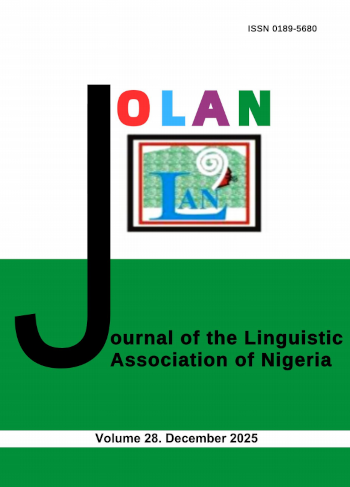Tonal Alternation in Yoruba Numerals
Keywords:
Yoruba, numeral, tonal alternation, tomorphAbstract
This study examines the alternation between Mid and Low tones in Yoruba numerals. It reports that the basic numbers ọ̀kan “one”, ẹ̀ ta “three”, and ẹ̀rin “four” all have L-M tonal structure, but the M becomes L when the numbers are combined with other number items in the formation of higher numerals such as ọ̀k ànlá “eleven”, ẹ̀t ạlá “thirteen” and ẹ̀r ìndínlógún “sixteen” among others. It is then argued that Yoruba has a numeral-marking L-tomorph that becomes active only when it is preceded by M. Examples are presented to show the linking of this L-tomorph in higher numerals in which the structural conditions are met.
References
Adeniyi, K. (2009). The Typology of Three-Tone Systems: Ebira, Ghotuo, Yala (Ikom), and Yoruba. M.A. Project, Department of Linguistics and African Languages, University of Ibadan, 102 pages. Unpublished.
Adeniyi, K. (2018). High Tone Lowering in Igbomina-Yoruba. JOLAN: Journal of the Linguistic Association of Nigeria, Supplement III, 221-231.
Adeniyi, K. & Elugbe, B. (2018). Consonant Voicing, Tonal Morphemes, and Downstep in Gwari. Linguistique et Langues Africaines 4, 77-97.
Adewusi, T. A. (2011). Aspects of tone in Yoruba grammar. M.A. Project, Department of Linguistics and African Languages, University of Ibadan.
Ajiboye, O. (2016). The Yoruba Numeral System. In: Ndimele O. & Chan E. (Eds.), The Numeral Systems of Nigerian Languages. Port Harcourt: M & J Grand Orbit Communications. 1-26.
Akinade, O. O. & Odejobi, O. A. (2014). Computational modelling of Yorùbá numerals in a numberto-text conversion system. Journal of Language Modelling, Vol 2, No 1, 167 – 211.
Akinlabi, A. (2004). The sound system of Yoruba. In: Lawal, N.S, Sadiku, MNO and Dopamu, A. (Eds). Understanding life and culture: Yoruba. NJ: Africa World Press Inc., 453-468.
Akinlabi, A. & Liberman, M. (2000). The tonal phonology of Yoruba clitics. In: Gerlach, B. & J. Grijzenhout (Eds.), Clitics in phonology, morphology and syntax. Amsterdam: Benjamins, 31 – 62.
Akinola, B. (2014). Traditional counting system in Ondo dialect of Yoruba. In: Oyebade, F. O. & N. C. Kammelu (eds.), The counting system of some dialects of Igbo, Hausa and Yoruba. Ibadan: Masterprint Publishers.
Babarinde, O (2013). The Linguistic Analysis of the Structure of the Yoruba Numerals. Journal of literature, languages and linguistics, Vol. 1, 78 – 88.
Bamgbose, A. (1965). Yoruba orthography: a linguistic appraisal with suggestions and for reform. Ibadan: University Press.
Bamgbose, A. (1967). A short Yoruba grammar. Ibadan: Heinemann.
Bamgbose, A. (1990) “Fonoloji ati Girama Yoruba”, Ibadan: University Press Plc.
Beavers, J. & Sells, P. (2013). Constructing and supporting a linguistic analysis. In Podesva, R. J. & D. Sharma, (Eds.), Research methods in Linguistics. Cambridge: Cambridge University Press, 397 –421.
Comrie, B. (2013). Numeral Bases. In: Dryer, M. S. & Haspelmath, M. (eds.), The World Atlas of Language Structures Online. Leipzig: Max Planck Institute for Evolutionary Anthropology. (Available online at http://wals.info/chapter/131, Accessed on 2020-03-09.)
Connell, B. & Ladd, D. R. (1990). Aspects of pitch realization in Yoruba. Phonology, 7 (1) 1 – 29.
Courtenay, K. (1968). A Generative Phonology of Yoruba. Ph. D. Dissertation. UCLA.
Ẹkúndayọ̀, S. (1977). Vigesimal Numeral Derivational Morphology: Yorùbá Grammatical Competence Epitomized, Anthropological Linguistics, 19(9):436–453, http://www.jstor.org/stable/30027551
Elugbe, B. (1985). The Tone System of Ghotuo. Cambridge Papers in Phonetics and Experimental Linguistics 4: 1-21.
Fabunmi, F. A. (2010). Vigesimal Numerals on Ifè (Togo) and Ifè (Nigeria) Dialects of Yorùbá. Linguistik Online 43.3.
Faturoti, O. R. (2014). Traditional counting method of the people of Omuo-Ekiti, Ekiti State, Nigeria. In: Oyebade, F. O. & N. C. Kammelu (eds.), The counting system of some dialects of Igbo, Hausa and Yoruba. Ibadan: Masterprint Publishers.
Hurford, J. R. (1975). The linguistic Theory of Numerals. Cambridge: Cambridge University Press.
Laniran, Y.O. (1992). Intonation in Tone Languages: The phonetic Implementation of Tones in Yoruba. Ph.D. Dissertation, Cornell University.
Laniran, Y.O. & G.N. Clements. (2003). Downstep and high raising: interacting factors in Yoruba tone Production. Journal of Phonetics 31, pp 203-250.
Mann, A. (1887). Notes on the Numeral System of the Yorùbá Nation. The Journal of the Anthropological Institute of Great Britain and Ireland, 16:59–64, available online http://www.jstor.org/stable/2841738.
Olubode-Sawe, F. (2016). Sources of Complexity in the Yoruba Numeral System. In: Ndimele O. & Chan E. (Eds.), The Numeral Systems of Nigerian Languages. Port Harcourt: M & J Grand Orbit Communications. 189-202.
Oyebade, F. O. (2014). Counting systems: an endangered aspect of the cultural knowledge and practices of our indigenous communities. In: Oyebade, F. O. & N. C. Kammelu (eds.), The counting system of some dialects of Igbo, Hausa and Yoruba. Ibadan: Masterprint Publishers.
Oyetade, S. O. (2011). The Yoruba language in Diaspora: lessons from the English language. Yoruba: Journal of the Yoruba Studies Association of Nigeria 6 (5), 1 – 24.














